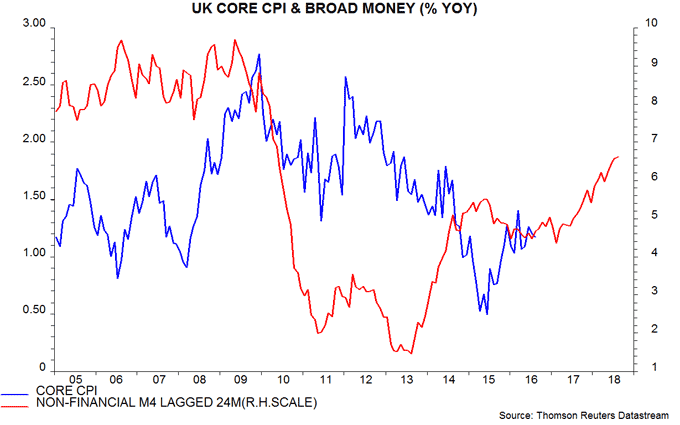UK 2017 inflation rise: blip or ratchet?
UK consumer price inflation is expected here to rise above 3% during 2017, exceeding Monetary Policy Committee (MPC) and consensus forecasts. The MPC is likely to try to avoid tightening policy in response, arguing that it intends to “look through” the increase, an approach it claims was successful in 2008 and 2011, when CPI inflation reached over 5% before falling back. Monetary growth, however, is much stronger than in those years, suggesting that the coming inflation rise will represent a permanent upward shift rather than a “temporary blip”. In reality, key MPC officials may now be covertly in favour of aiming for a sustained overshoot of the inflation target, a policy recently embraced explicitly by the Japanese monetary authorities.
A post in May presented long-term evidence showing that all major swings in “core” inflation (i.e. excluding food / energy costs, tax effects etc) since World War 2 were preceded by a significant change in monetary growth, typically by between two and three years. Annual broad money growth, as measured by non-financial M4, has been trending higher since 2011, reaching 6.6% in August, the fastest since 2008. Monetary forces, therefore, will be pushing up on inflation in 2017 and 2018 – see first chart*.
The rise in core inflation to date has been delayed and muted by the lagged impact of exchange rate strength over 2013-15. The currency effect, of course, is about to become a powerful tailwind. Manufactured import prices rose by 7.3% in the year to August and annual growth is likely to reach 10-15% by early 2017, barring a significant recovery in sterling. Import price changes appear to have their maximum impact on core CPI inflation after about a year, suggesting strong upward pressure from late 2016 – second chart.
Core CPI inflation, therefore, is expected here to rise from 1.2% in August to about 2.5% by late 2017. Headline CPI inflation, meanwhile, is likely to be pushed significantly above the core rate by rising energy and food prices due to sterling weakness and stronger global commodity costs. Based on current sterling commodity prices, the headline-core inflation gap may increase to over 1 percentage point by mid-2017 – third chart. Combined with a strengthening core trend, this would probably be sufficient to lift the headline rate above 3%.
The CPI inflation surges in 2008 and 2011 proved temporary partly because they occurred against a backdrop of weak and falling monetary growth – the annual increase in non-financial M4 bottomed at 2.0% in 2009 and 1.5% in 2011. Recent strong growth has yet to peak, suggesting that core CPI inflation will remain under upward pressure until late 2018, at least. The coming inflation overshoot, therefore, is likely to be sustained, unless global commodity prices turn down afresh or sterling stages an improbable large recovery.
*Core CPI = CPI excluding energy, food, alcohol, tobacco and education, and adjusted for VAT changes.

Reader Comments